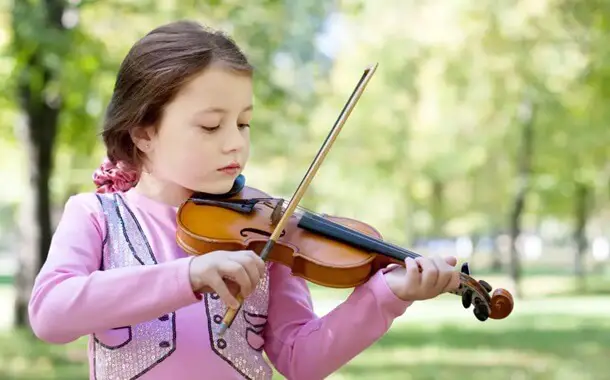How Much do Violin Lessons Cost?
Have you dreamed of your child learning violin, perhaps envisioning a mini Vivaldi practicing at home? As you consider lessons, costs might worry you. This guide breaks down violin prices and what to watch for when choosing an instructor.
How Much do Violin Lessons Cost?
So what can you expect to budget overall? The cost of violin lessons is from $15-$100 or more per hour-long class. Exact pricing depends on factors like teacher experience level if it’s private or group format, and so on.
Private Violin Lessons
Personal one-on-one violin classes with a teacher run $15-$35 per half hour session for beginners. More qualified instructors charge $40-$100+ per half hour.
Group Violin Lessons Prices
Sharing a teacher with other students in group lessons cuts costs for each person. Expect to pay around $40-$100 per month in total. Groups work well to supplement private lessons. But most kids need some one-on-one attention to truly progress.
A Reddit discussion had users talk about pricing for violin lessons, with rates ranging from $15 to $110 per half hour or hour according to them, depending on the teacher’s experience and location.
Johnson String Instrument notes that average cost for violin lessons is generally in the range of $55-$75 per hour. However, the specific cost will depend on the type of lesson, whether private or in a group setting, and the student’s skill level.
TakeLessons, on the other hand, states that you can learn the violin for a price usually between $15-$100 per hour, depending on the teacher’s skills and the type of class, whether private or group.
Wyzant tutors in New Jersey cost $35 – $60 per hour on average.
LessonWithYou.com has an article in which it states that in New York City, the average price for a one-hour violin lesson is $60-$100, with costs varying based on the teacher’s education and performing level, the location, and whether the lessons are in-person or online.
Why Private Lessons Work Best
While pricier than group alternatives, private lessons have huge advantages, especially for kids first starting out.
Customized Learning
One-on-one attention lets teachers personalize the experience for each student. They can speed up, slow down, or adjust teaching methods to match how each child best learns. No one gets left behind or held back by others.
Build Confidence
With a personalized approach, students stay engaged and motivated. They don’t get frustrated or feel dumb next to peers who grasp concepts quicker. This prevents kids from getting discouraged early on.
Develop Practice Skills
A teacher can instill good violin practice habits during private sessions. These tools help maximize student improvement between lessons. Kids learn how to structure time alone productively.
Stay Accountable
One-on-one attention keeps students committed to progressing. Having set lesson times and an encouraging teacher provides accountability. Especially when kids hit occasional slumps in motivation.
Factors Affecting Private Lesson Pricing
Of course, all violin instructors don’t charge the same rates. Several factors cause price ranges, including:
Teacher Expertise
Advanced degrees in music performance/education or special teacher certifications allow charging higher lesson rates. It takes great skill to teach violin fundamentals correctly from square one. So formal mastery deserves fair compensation.
Kid Teaching Experience
Even talented musicians can struggle to teach children unless they have enough background to engage young students. Avoiding bad habits requires patience and adapting educational tactics to each child’s needs. Look for an instructor well-versed in kid lesson best practices.
Paying a higher rate for the right teacher is an investment in quality skill-building. Avoid attempts to save money with someone under qualified.
Additional Costs Beyond Violin Teacher Lessons
 While instruction costs most in your budget, a few other violin expenses will pop up too. These include:
While instruction costs most in your budget, a few other violin expenses will pop up too. These include:
Sheet Music – Violin teachers often assign new songs and exercises weekly. Individual sheet music ranges between $2-$5 to purchase typically.
Instrument Upgrades – As kids grow or advance, upgrading violin sizes ensures proper learning and technique. Full-size options work for most teens. Expect at least $100-$300+ for a quality starter instrument, along with another few hundred for later upgrades.
Violin Supplies – Things like rosins, strings, cases, and cleaning cloths don’t break the bank but do add up. Budget around $150-$200 for accessories to care for your child’s violin properly.
Recital Costs – Many instructors organize annual or bi-yearly recitals. While optional, performing builds confidence! Typical expenses like tickets, outfits, and photos run $50-$100 total.
How To Save Money on Lessons
While very important, lessons/supplies can hit budgets, especially for multiple kids. Use these tips to keep violin learning accessible:
Buy Group Packages – Paying upfront for 5-10 music lessons on how to play the violin at once offers per-class discounts. Just confirm refund policies if discontinuing later on.
Split Costs with Friends – If your child has a violin buddy, taking joint lessons saves money. Some teachers even discount paired lessons.
Barter Services – Teachers running side businesses often barter services like social media help, photography, cleaning, etc to cut costs.
Use School Programs – Many elementary bands offer violin access and classes. While quality varies, it’s worth checking availability to save on private lessons.
Rent-To-Own Accessories – Starter violin rentals on long-term cost $15-$30 monthly, a lot cheaper than buying a new one. Some music shops also rent cases and other supplies to purchase later at a discount.
Online Violin Lessons – You can also try online lessons as they are cheaper, although a face-to-face approach with a private teacher will always work better.
Shop Second-Hand – Used violins, cases, and accessories offer huge savings. Try consignment shops, Craigslist, eBay, Facebook Marketplace, or school bulletins.
Is Violin Right for Your Child?
Deciding if lessons suit your family depends on many factors. Assess your child’s interest level, ability to commit focus/practice time, budget flexibility, access to quality local violin tutors, and more.
In most cases, children can pick up fundamentals quite well starting around ages 4-6. But don’t despair about an “ideal age” if your kid discovers violin passion later on! Patience and the right instructor smooths the learning curve at any age.
If curiosity has struck your young one, explore options in your area! Reach out to chat more about getting started.


Leave a Reply
Want to join the discussion?Feel free to contribute!